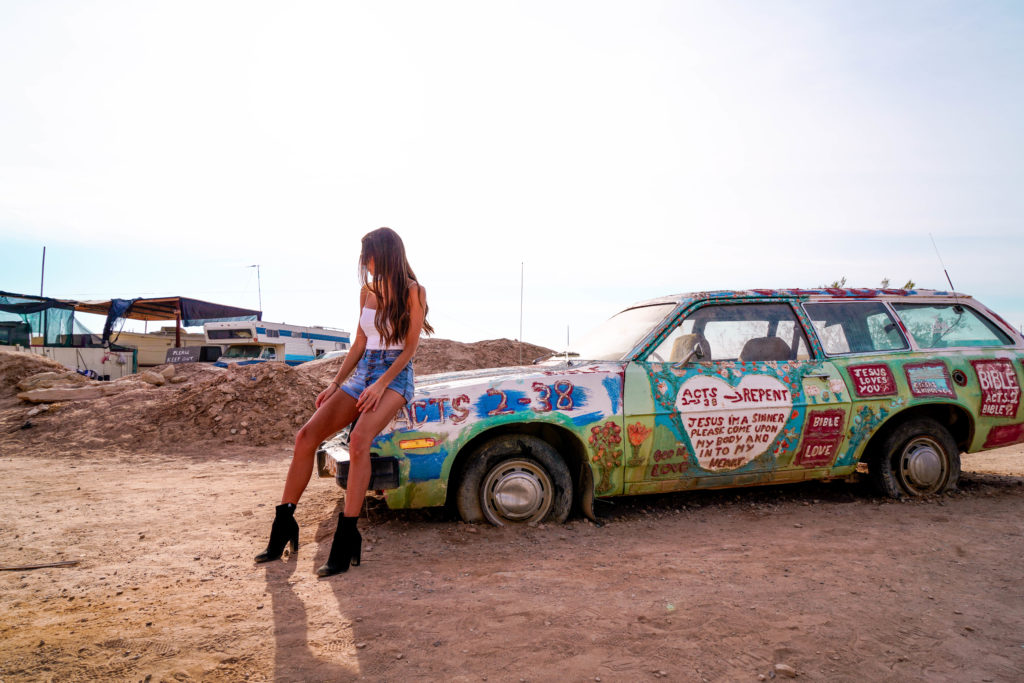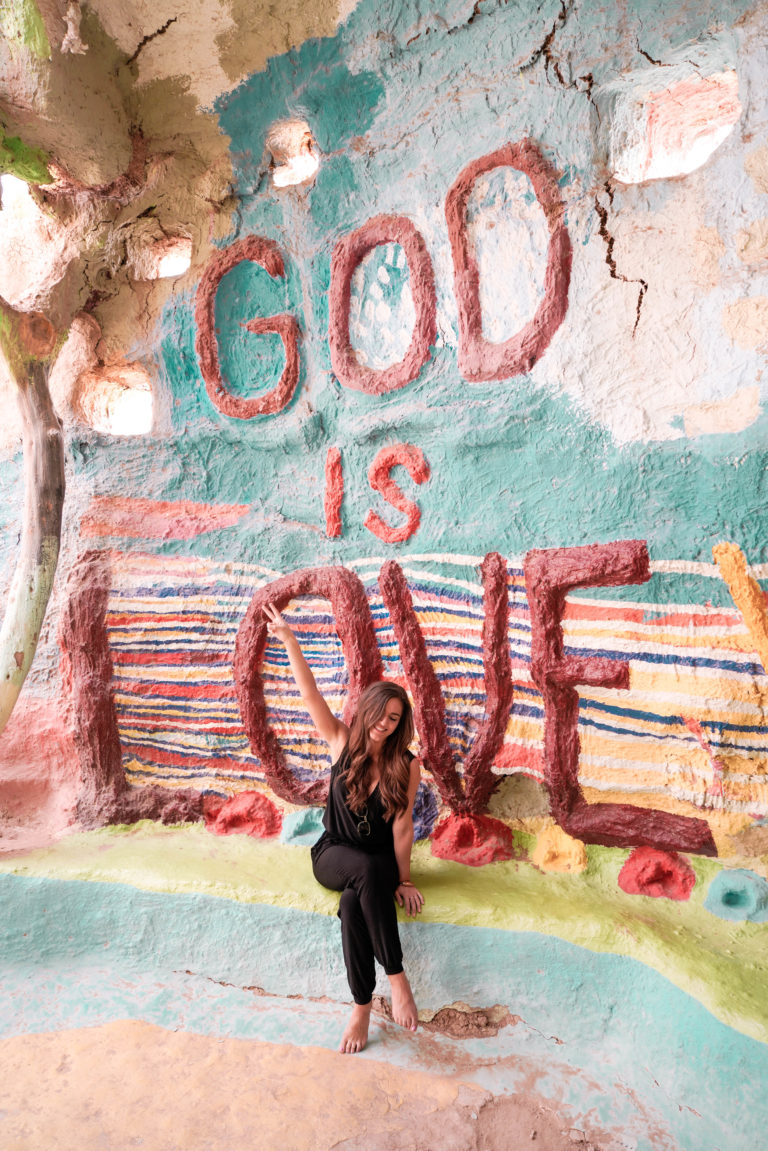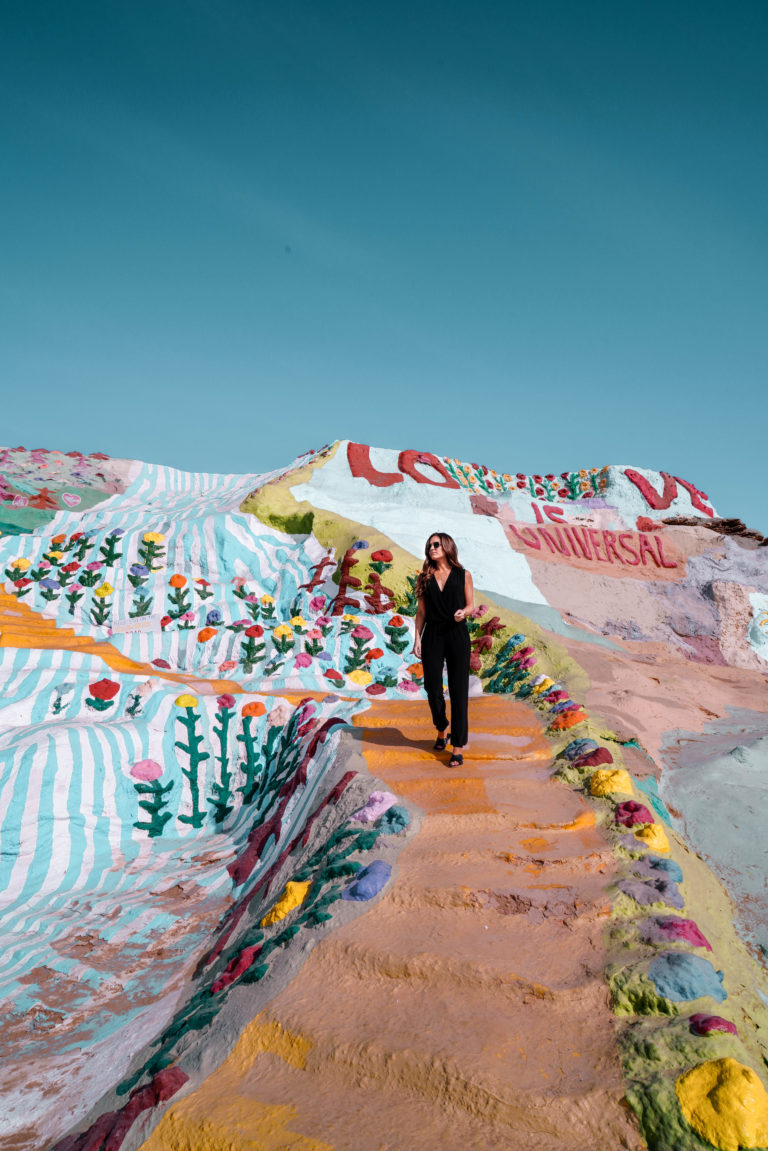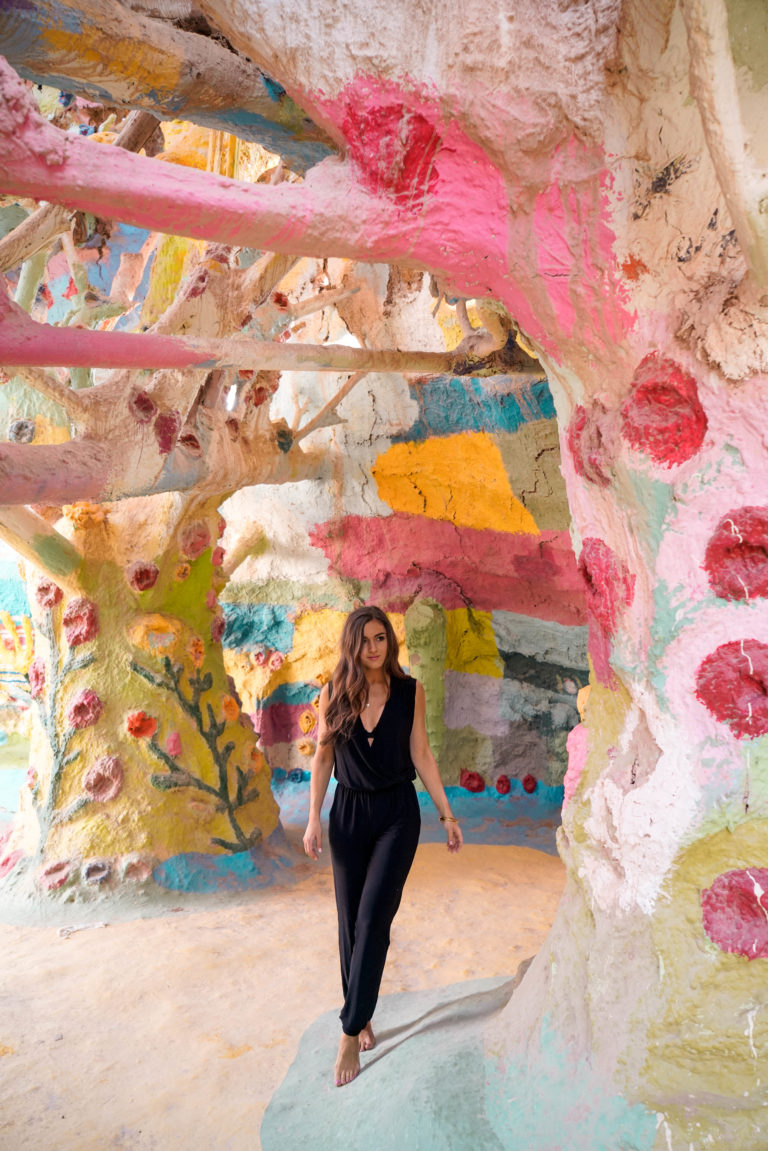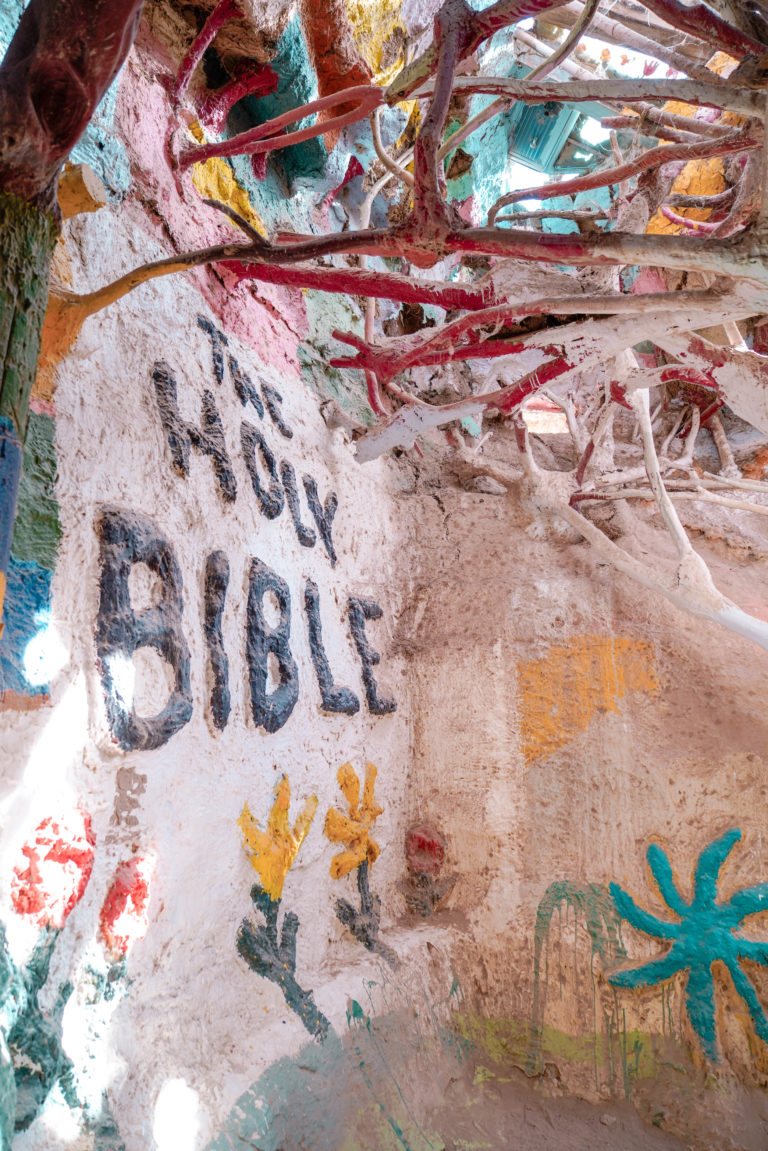The Man and Mission Behind Salvation Mountain: What to Know Before Your Visit
You’ve seen it on TV, the internet, Instagram – the strange yet serene United States road trip mecca that looks like it leaped straight off the Candyland board game and into the Colorado Desert: Salvation Mountain. It’s on one hand incredibly accessible, with no entrance fees or reservations required, and on the other hand isolated by miles and miles of flat desert in a town that otherwise would have never made it into a travel guide, making the visit something of a pilgrimage, whether spiritual or not.
But what’s even more intriguing than the location of this massive piece of desert folk art is the story behind it, and, specifically, the man behind it. I was able to pay Salvation Mountain a visit on my recent Southwest United States road trip (from Phoenix, Arizona to San Diego, California, with a handful of stops in between), and I’m still affected by the inspiring story behind this colorful little oasis.
Salvation Mountain, with the Sinner's Prayer enclosed in a bright red heart, perched above the boats and blue waves of the "Sea of Galilee"
The story of A Resilient Drifter
The story of Salvation Mountain begins with a man named Leonard Knight, a California drifter born in 1931, who first made several failed attempts to spread God’s love through a hot air balloon. After his Christian conversion experience at age 36 (which took place in the humblest and most ironic of places: in his van in San Diego, hiding from his sister’s persistent evangelism), he became passionate about sharing his religious revelation: “Love is universal. Love God, love one another, and just keep it simple!”
He prayed for 10 years for a hot air balloon, hoping to decorate it with the words “God is Love,” and fly it above cities and towns as a quiet and playful message of hope. But 10 years came and went, and still without a balloon, Leonard realized he would have to be more proactive.
As he headed out West from his family home in Vermont, Leonard’s live-in van broke down. Equipped with a second-hand sewing machine, he saw the setback as an opportunity to begin weaving together a colorful patchwork of fabric scraps that would hopefully become his floating artistic pulpit. After several years, Leonard and his balloon continued West until arriving in Niland, California, near Slab City, where he intended to complete and launch his project. But after 14 years, the fabric had irreparably rotted and torn, his project had to be abandoned.
Discouraged, Leonard decided to leave town after creating a “small statement” – an eight foot cement balloon. He planned to stay for a week. But weeks became months and months became years, until this small monument had grown over 50 feet tall, made of cement mixed with sand, and junk and paint found at the nearby dump. He reported that he “used to spend half a day at the dump to find half a gallon of paint of which only half was usable.” The construction was unstable, however, and one day Leonard’s four years of tireless work came crashing to ground in a pile of sandy rubble.
Perhaps made resilient by a childhood spent doing laborious farm work, or years of military training as a mechanic, or setback after setback (with more to come) in his spiritual mission, Leonard wasn’t discouraged this time. He thanked God for showing him that the mountain wasn’t safe, and began again in 1989, proclaiming, “Now God, You build it.”
This time, Leonard rebuilt the mountain with “more smarts,” using native adobe clay mixed with straw – a technique he learned from the architecturally-ingenious, native Navajo people living in the area. Additionally, Leonard relied on lead-free paint (an estimated 100,000+ gallons of it, to be exact), to coat the surface of his structure – a decision which ultimately saved the Salvation Mountain’s life after the Imperial County attempted to have it bulldozed, citing faulty lead tests performed on the soil (in the end, Leonard submitted additional, impartial tests that proved the paint’s safety). Leonard continued adding to the artwork until his death on February 10, 2014.
The Salvation Mountain of Today
Despite numerous obstacles – rejection from his hometown church leaders, waiting a decade for a hot air balloon that never came, a broken down van, a rotted mass of sewn fabric patchwork, years of labor that crumbled to pieces before his eyes, and the county’s efforts to bulldoze his artwork, to name a few – Leonard never gave up, never hardened, and never stopped pursuing new, creative ways to share what he knew to be a universal truth: God is Love.
And if it hadn’t been for Leonard Knight’s relentless efforts, combined with the support he received from his community and the donations of visitors, we wouldn’t have the Salvation Mountain we know and adore today – this vibrant desert oasis built from the scraps of the earth on which it stands, with a simple white cross perched at the summit as a beacon of hope for all who visit.
In the decades since its birth, Salvation Mountain has been named a National Treasure in the U.S. Congressional Record and a National Folk Art Site, turned up in the movie Into the Wild, was featured on National Geographic, Ripley’s Believe It or Not, and the Discovery Channel, and draws to it upwards of 2,000 people a week from every corner of the globe. It also inspired the formation of a non-profit group, Salvation Mountain, Inc., that works to protect and preserve this manmade monument which, unsurprisingly, requires a serious amount of upkeep and care to keep from meeting the same fate as its predecessor (you can donate to the Salvation Mountain fund here!).
Visiting Salvation Mountain: What Not to Miss
Salvation Mountain is a must-see when exploring the Southwest United States, not only to appreciate its artistic beauty and architectural resourcefulness, but also to pay homage to this spiritual masterpiece, the man behind it, and the Big Man behind him. Who knows, you may even encounter God in the wood and straw igloos or along the painted “yellow brick road,” as I’m sure Leonard would have hoped.
When visiting Salvation Mountain, don’t miss:
1) The “Museum”
The “Museum” consists of several large domed areas modeled after Leonard’s semi-inflated hot air balloon. It’s an impressive construction of bales of hay, adobe, and “trees” made from pieces of desert wood threaded through old tires. Inside you’ll find a collection of small but significant items given to Leonard by friends and visitors, and Leonard’s “roses” which he made by punching his fist into a blob of adobe clay.
2) The Hogan
Leonard actually originally intended to live in the Hogan. Built with the same techniques use by the native Navajo, the straw and adobe form insulation from the blazing summer heat. Leonard never moved in, however, as he preferred to live in his truck. Today, it serves as a sort of altar, where believers who have sought out the Mountain on a spiritual pilgrimage will pray and leave a gift to symbolize giving oneself to God.
3) The Sinner’s Prayer
You’ll find this prayer painted in a prominent red heard at the center of the Mountain and present throughout the rest of the monument. This is the same prayer that Leonard repeated over and over in his van in San Diego in 1967, sparking the onset of his life mission.
4) The Sea of Galilee
This image sits at the base of the Mountain, and upon which visitors can stand while viewing the colorful bands of painted waterfalls, lakes, flowers, and trees, adorned with Bible verses.
5) The Folk Art Society plaque
This was one of Leonard’s most treasured possessions, designating Salvation Mountain as a National Folk Art Site and a place “worthy of protection and preservation.” You’ll find it molded into the clay walls in the Museum.
6) The extraordinary amount of effort it takes to keep this place alive
Salvation Mountain is sustained entirely by donations and a small handful of volunteers. I met one of the men who lives at the Mountain and cares for it full-time, slathering coat after coat of donated, pastel-colored paint on exposed cracks in the Mountain, and giving tours when requested. He agrees that it’s a remarkable place, draws interesting people from all over the world, and it only survives thanks to the generosity of its fans.
If you’re making the trip there, consider bringing a couple gallons of paint or some cash to donate. If you can’t visit in person, you can contribute to the preservation of the site by donating online.
Let’s Go.
Whether it’s spirituality, the art & architecture, sheer curiosity, or God Himself that brings you to Salvation Mountain, you won’t be disappointed. Many people leave feeling a connection to the Mountain, perhaps because they left objects from their pockets in the Hogan, or perhaps because of the transcendent joy they felt skipping through the yellow brick road. At the very least, I hope you’ll leave feeling deeply appreciative of people like Leonard Knight who, although embarrassed to call himself an artist, dedicated his life to making a piece of public artwork “as pretty as Jesus.”
What are your thoughts on Salvation Mountain? Have you been? Is it on your bucket list? Leave your thoughts in the comments below!


